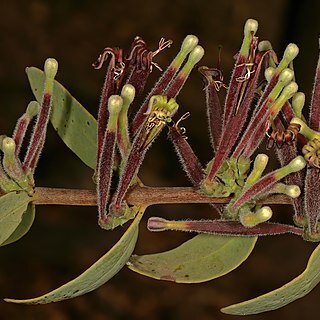Corolla tube 2.7–3.3 cm long, dull red to purple, base and lobes light green, pilose to villous with spreading hairs 0.5–2 mm long, sometimes only shortly hairy on lobes; bud heads 4–5 × 2.5–3 mm, oblong-ellipsoid, only slightly angled; basal swelling 3–4 mm across, ovoid-ellipsoid, globose or depressed-globose; lobes c. 9 mm long, reflexed, the upper expanded part 4–5 × 1.2–1.5 mm.
Shrub, up to 1.5 m high, hemiparasitic. Leaves at maturity shortly petiolate; blade narrowly ovate-oblong, 30-40 x 10-20 mm; petioles 2-4 mm long. Flowers: in 4-6-flowered umbels solitary in leaf axils; corolla 35-40 mm long, villous-pilose, swollen base green, tube reddish purple, apex green; Aug.-Jan. Fruit ellipsoid, 10-12 mm long, red, slightly warty.
Leaves opposite or subopposite, sometimes clustered at older nodes; petiole 2–4 mm long, puberulous; lamina coriaceous, dull green to glaucous, 2–6.5(9) × 1–2.5(5) cm, lanceolate to narrowly elliptic or ovate-elliptic, mostly obtuse at apex, cuneate to rounded at base, glabrous, with 4–8 pairs of spreading-ascending nerves.
petiolate, glabrous. Corolla villous-pilose pubescent, tube swollen at base, lobes reflexed. Parasitic primarily on species of Acacia. Flowers with corolla base green, tube reddish purple, apex green.
Umbels 1–several per axil, 2–4-flowered; peduncle 1–3 mm long; pedicels 0–2 mm long; bract 2–3 mm long, cupular, with a small triangular limb.
Stems spreading to 1 m or more; twigs puberulous, sometimes with longer hairs on youngest parts.
Calyx 2–2.5 mm long, cupular, flared, slightly toothed, densely hairy.
Stamen filaments red; tooth 0.5–0.8 mm long; anthers 2.5–3 mm long.
Style with neck 2–3 mm long; stigma 0.8 mm across, capitate.
Berry red, 10 × 8 mm, obovoid-globose, glabrescent.
Receptacle 1–1.5 mm long.

